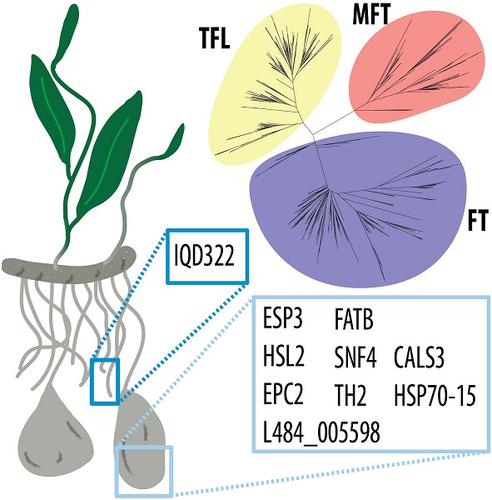当前位置:
X-MOL 学术
›
Evol. Dev.
›
论文详情
Our official English website, www.x-mol.net, welcomes your
feedback! (Note: you will need to create a separate account there.)
Comparative transcriptomics of a monocotyledonous geophyte reveals shared molecular mechanisms of underground storage organ formation
Evolution and Development ( IF 2.6 ) Pub Date : 2021-01-19 , DOI: 10.1111/ede.12369 Carrie M Tribble 1 , Jesús Martínez-Gómez 1, 2 , Fernando Alzate-Guarín 3 , Carl J Rothfels 1 , Chelsea D Specht 2
Evolution and Development ( IF 2.6 ) Pub Date : 2021-01-19 , DOI: 10.1111/ede.12369 Carrie M Tribble 1 , Jesús Martínez-Gómez 1, 2 , Fernando Alzate-Guarín 3 , Carl J Rothfels 1 , Chelsea D Specht 2
Affiliation

|
Many species from across the vascular plant tree‐of‐life have modified standard plant tissues into tubers, bulbs, corms, and other underground storage organs (USOs), unique innovations which allow these plants to retreat underground. Our ability to understand the developmental and evolutionary forces that shape these morphologies is limited by a lack of studies on certain USOs and plant clades. We take a comparative transcriptomics approach to characterizing the molecular mechanisms of tuberous root formation in Bomarea multiflora (Alstroemeriaceae) and compare these mechanisms to those identified in other USOs across diverse plant lineages; B. multiflora fills a key gap in our understanding of USO molecular development as the first monocot with tuberous roots to be the focus of this kind of research. We sequenced transcriptomes from the growing tip of four tissue types (aerial shoot, rhizome, fibrous root, and root tuber) of three individuals of B. multiflora. We identified differentially expressed isoforms between tuberous and non‐tuberous roots and tested the expression of a priori candidate genes implicated in underground storage in other taxa. We identify 271 genes that are differentially expressed in root tubers versus non‐tuberous roots, including genes implicated in cell wall modification, defense response, and starch biosynthesis. We also identify a phosphatidylethanolamine‐binding protein, which has been implicated in tuberization signalling in other taxa and, through gene‐tree analysis, place this copy in a phylogenetic context. These findings suggest that some similar molecular processes underlie the formation of USOs across flowering plants despite the long evolutionary distances among taxa and non‐homologous morphologies (e.g., bulbs vs. tubers). (Plant development, tuberous roots, comparative transcriptomics, geophytes).
中文翻译:

单子叶植物的比较转录组学揭示了地下储存器官形成的共同分子机制
维管植物生命树中的许多物种已将标准植物组织改造成块茎、鳞茎、球茎和其他地下储存器官 (USO),这些独特的创新使这些植物能够撤退到地下。由于缺乏对某些 USO 和植物进化枝的研究,我们理解形成这些形态的发育和进化力量的能力受到限制。我们采用比较转录组学方法来表征多花(六出科)块茎根形成的分子机制,并将这些机制与其他不同植物谱系的 USO 中确定的机制进行比较;B. 多花作为第一个具有块根的单子叶植物成为此类研究的重点,填补了我们对 USO 分子发育的理解的关键空白。我们从三个多花芽孢杆菌个体的四种组织类型(气生枝、根茎、须根和块根)的生长尖端测序转录组. 我们鉴定了块茎和非块茎根之间差异表达的同种型,并测试了与其他类群地下储存有关的先验候选基因的表达。我们确定了 271 个在块茎与非块茎根中差异表达的基因,包括与细胞壁修饰、防御反应和淀粉生物合成有关的基因。我们还鉴定了一种磷脂酰乙醇胺结合蛋白,该蛋白与其他类群的结节信号传导有关,并通过基因树分析,将此副本置于系统发育背景中。这些发现表明,尽管类群和非同源形态(例如鳞茎与块茎)之间的进化距离很长,但一些相似的分子过程是开花植物中 USO 形成的基础。(植物发育、块根、
更新日期:2021-01-19
中文翻译:

单子叶植物的比较转录组学揭示了地下储存器官形成的共同分子机制
维管植物生命树中的许多物种已将标准植物组织改造成块茎、鳞茎、球茎和其他地下储存器官 (USO),这些独特的创新使这些植物能够撤退到地下。由于缺乏对某些 USO 和植物进化枝的研究,我们理解形成这些形态的发育和进化力量的能力受到限制。我们采用比较转录组学方法来表征多花(六出科)块茎根形成的分子机制,并将这些机制与其他不同植物谱系的 USO 中确定的机制进行比较;B. 多花作为第一个具有块根的单子叶植物成为此类研究的重点,填补了我们对 USO 分子发育的理解的关键空白。我们从三个多花芽孢杆菌个体的四种组织类型(气生枝、根茎、须根和块根)的生长尖端测序转录组. 我们鉴定了块茎和非块茎根之间差异表达的同种型,并测试了与其他类群地下储存有关的先验候选基因的表达。我们确定了 271 个在块茎与非块茎根中差异表达的基因,包括与细胞壁修饰、防御反应和淀粉生物合成有关的基因。我们还鉴定了一种磷脂酰乙醇胺结合蛋白,该蛋白与其他类群的结节信号传导有关,并通过基因树分析,将此副本置于系统发育背景中。这些发现表明,尽管类群和非同源形态(例如鳞茎与块茎)之间的进化距离很长,但一些相似的分子过程是开花植物中 USO 形成的基础。(植物发育、块根、











































 京公网安备 11010802027423号
京公网安备 11010802027423号